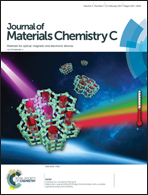Ratiometric dual-emitting MOF⊃dye thermometers with a tunable operating range and sensitivity†
Abstract
A tetracarboxylic acid ligand containing a highly polarized benzothiadiazole moiety was designed and used to construct the luminescent porous MOF ZJU-21, which can efficiently absorb the luminescent dye 4-[p-(dimethylamino)styryl]-1-methylpyridinium (DMASM) into the pores as well as sensitize it, yielding a dual-emitting MOF⊃dye composite ZJU-21⊃DMASM. The emission color of the resulting composite can be modulated by controlling the amount of dyes, and the intensity ratio of the two emissions can be used as a ratiometric thermometric parameter for temperature measurement. ZJU-21⊃DMASM also exhibits excellent temperature-dependent photoluminescence properties in the physiological temperature range, which, as well as the temperature and sensitivity ranges, can be tuned by controlling the concentration of DMASM in the pores of the host framework. Moreover, the proposed scheme can be readily applied to other luminescent porous MOFs and organic dyes, thereby providing a new perspective for the design of MOF⊃dye ratiometric temperature sensors.



 Please wait while we load your content...
Please wait while we load your content...